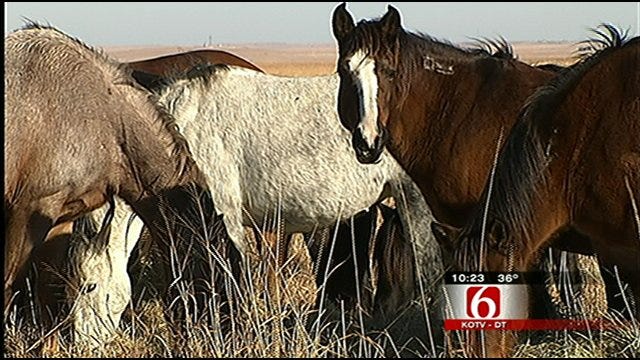Oklahoma Spending Millions Of Taxpayer Dollars To House Wild Horses
Wild horses are roaming on private ranches across the state and Oklahomans are footing the bill.Tuesday, January 25th 2011, 10:17 pm
Amy Lester, Oklahoma Impact Team
PAWHUSKA, Oklahoma -- Wild horses are roaming on private ranches across the state and Oklahomans are footing the bill.
"The question is, where do we spend the best dollar, the wisest for the American people?" asked U.S. Senator Tom Coburn, (R) Oklahoma. "We're just throwing money away."
Senator Coburn is against the way the Bureau of Land Management, or BLM, manages the program. Right now, there are roughly 27,000 horses on long term pastures. They'll live there the rest of their lives. Oklahomans' tax dollars support them, at an average of $475 per horse, per year. That money goes directly to ranchers, including 13, this year in Oklahoma.
"There's not many things you can do in agriculture to change up your cash flow so this was a good program for that," said Ladd Drummond, a rancher in northeastern Oklahoma.
Drummond has 2,200 horses on his land. The government pays him $1.30 per horse, per day. That's $1.04 million a year. Drummond said less than 10 percent is profit, or close to $100,000. He has to dedicate seven acres to each horse. He gives them supplemental feedings in the winter and puts out salt and mineral in the summer.
"You have a lot of expenses that go into it, but, there's definitely a little profit built in too, it's hard to do anything without making a little profit," said Drummond.
It's the amount of money that the government is paying to house the horses that has many people fired up. The younger horses are in short term holding, waiting to see if the public will adopt them.
Find out how to adopt a wild horse.
The cost to keep horses in government run short term corrals is much higher, around $5.50 a day or more than $20 million a year. Senator Coburn said that's too much money. He insists the law tells the agency to either adopt extra animals or kill them.
"When you have an excess of animals, not humans, animals, above and beyond your capability to care for them, what you have to do is destroy that herd down to a level that we can manage it," said Sen. Tom Coburn.
Read about the history of the program.
Many people don't agree with Coburn's suggestion. Instead, some have other ideas, including Madeleine Pickens, the wife of T. Boone Pickens. She wants to save the horses and put them in a wild horse sanctuary for the public to visit.
"There's a catastrophe out there with all of these horses and we have to do something about it," said Madeleine Pickens. "I'm very confident in my plan."
Pickens wants to take the horses out of the more expensive short term holding and put them on her close to 20,000 acres of land in Nevada. She bought the land, started a not for profit organization and donated the land to it. She still wants the government to pay the not for profit $1.50 per horse, per day. That's within the range of what ranchers get.
"I don't have unlimited funds, so I find it amusing when someone says 'Tell her to do it herself. She's got lots of money.' I'm not Boone Pickens, I'm married to Boone Pickens. I'm doing it with my money," said Pickens.
The Bureau of Land Management is also against slaughtering horses. Plus, they say Congress has told them not to do that either. The agency is currently reviewing Pickens' proposal. Pickens has been working on this for three years. Instead, they're working on new fertility control treatments and they're developing a plan to try and save money.
"We don't want to see our budget increase anymore than the taxpayers do. Our goal is to balance what we're doing within a smaller budget," said Debbie Collins, National Wild Horse & Burro Program Specialist.
Read the Office of Inspector General's report on the program.
More Like This
January 25th, 2011
January 2nd, 2025
September 29th, 2024
Top Headlines
April 29th, 2025
April 29th, 2025
April 29th, 2025
April 29th, 2025












